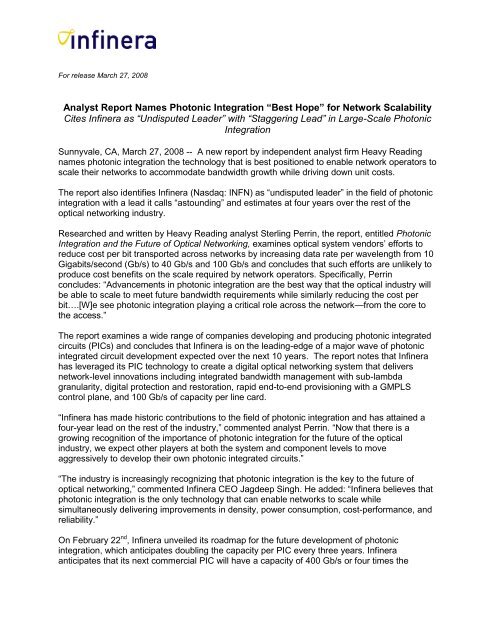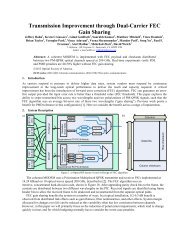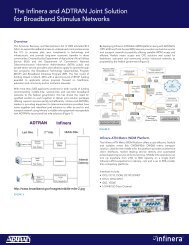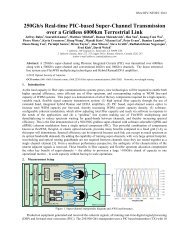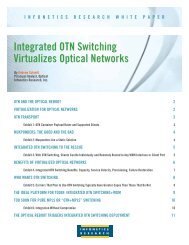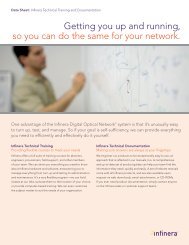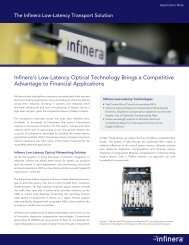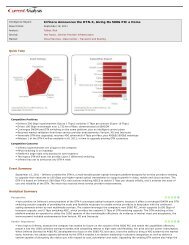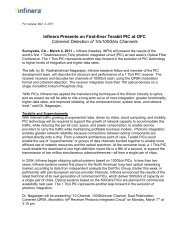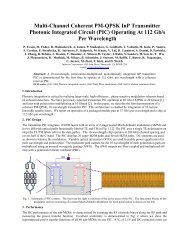PDF Version (100 KB) - Infinera
PDF Version (100 KB) - Infinera
PDF Version (100 KB) - Infinera
Create successful ePaper yourself
Turn your PDF publications into a flip-book with our unique Google optimized e-Paper software.
For release March 27, 2008Analyst Report Names Photonic Integration “Best Hope” for Network ScalabilityCites <strong>Infinera</strong> as “Undisputed Leader” with “Staggering Lead” in Large-Scale PhotonicIntegrationSunnyvale, CA, March 27, 2008 -- A new report by independent analyst firm Heavy Readingnames photonic integration the technology that is best positioned to enable network operators toscale their networks to accommodate bandwidth growth while driving down unit costs.The report also identifies <strong>Infinera</strong> (Nasdaq: INFN) as “undisputed leader” in the field of photonicintegration with a lead it calls “astounding” and estimates at four years over the rest of theoptical networking industry.Researched and written by Heavy Reading analyst Sterling Perrin, the report, entitled PhotonicIntegration and the Future of Optical Networking, examines optical system vendors’ efforts toreduce cost per bit transported across networks by increasing data rate per wavelength from 10Gigabits/second (Gb/s) to 40 Gb/s and <strong>100</strong> Gb/s and concludes that such efforts are unlikely toproduce cost benefits on the scale required by network operators. Specifically, Perrinconcludes: “Advancements in photonic integration are the best way that the optical industry willbe able to scale to meet future bandwidth requirements while similarly reducing the cost perbit….[W]e see photonic integration playing a critical role across the network—from the core tothe access.”The report examines a wide range of companies developing and producing photonic integratedcircuits (PICs) and concludes that <strong>Infinera</strong> is on the leading-edge of a major wave of photonicintegrated circuit development expected over the next 10 years. The report notes that <strong>Infinera</strong>has leveraged its PIC technology to create a digital optical networking system that deliversnetwork-level innovations including integrated bandwidth management with sub-lambdagranularity, digital protection and restoration, rapid end-to-end provisioning with a GMPLScontrol plane, and <strong>100</strong> Gb/s of capacity per line card.“<strong>Infinera</strong> has made historic contributions to the field of photonic integration and has attained afour-year lead on the rest of the industry,” commented analyst Perrin. “Now that there is agrowing recognition of the importance of photonic integration for the future of the opticalindustry, we expect other players at both the system and component levels to moveaggressively to develop their own photonic integrated circuits.”“The industry is increasingly recognizing that photonic integration is the key to the future ofoptical networking,” commented <strong>Infinera</strong> CEO Jagdeep Singh. He added: “<strong>Infinera</strong> believes thatphotonic integration is the only technology that can enable networks to scale whilesimultaneously delivering improvements in density, power consumption, cost-performance, andreliability.”On February 22 nd , <strong>Infinera</strong> unveiled its roadmap for the future development of photonicintegration, which anticipates doubling the capacity per PIC every three years. <strong>Infinera</strong>anticipates that its next commercial PIC will have a capacity of 400 Gb/s or four times the
- 2 -capacity of its current PIC. <strong>Infinera</strong>’s current PICs, which began shipping in 2004, haveachieved more than 50 million cumulative hours of operation in live networks with zero failures.The Heavy Reading report Photonic Integration and the Future of Optical Networking, can bepurchased at www.heavyreading.com.For further informationMedia:Jeff Ferry<strong>Infinera</strong>Tel. +1-408-572-5213jferry@infinera.comInvestors:Bob Blair<strong>Infinera</strong>Tel. +1-408-716-4879bblair@infinera.comAbout <strong>Infinera</strong><strong>Infinera</strong> provides Digital Optical Networking systems to telecommunications carriers worldwide.<strong>Infinera</strong>’s systems are unique in their use of a breakthrough semiconductor technology: thePhotonic Integrated Circuit (PIC). <strong>Infinera</strong>’s systems and PIC technology are designed toprovide optical networks with simpler and more flexible engineering and operations, faster timeto-service,and the ability to rapidly deliver differentiated services without reengineering theiroptical infrastructure. For more information, please visit www.infinera.com.This press release contains certain forward-looking statements based on current expectations,forecasts and assumptions that involve risks and uncertainties. These statements are based oninformation available to <strong>Infinera</strong> as of the date hereof; and actual results could differ materiallyfrom those stated or implied, due to risks and uncertainties. Forward-looking statements includestatements regarding <strong>Infinera</strong>’s expectations, beliefs, intentions or strategies regarding thefuture, such as the benefits and capabilities of our products and the Digital Optical Network’sarchitecture, that <strong>Infinera</strong> is on the leading-edge of a major wave of photonic integrated circuitdevelopment expected over the next 10 years, that increasing data rate per wavelength isunlikely to produce cost benefits on the scale required by network operators, that <strong>Infinera</strong> hasleveraged its PIC technology to create a system that delivers network-level innovationsincluding integrated bandwidth management with sub-lambda granularity, digital protection andrestoration, network management with an end-to-end GMPLS control plane, and <strong>100</strong> Gb/s ofcapacity per line card, that photonic integration is the key to the future of optical networking, thatphotonic integration is the only technology that can enable networks to scale whilesimultaneously delivering improvements in density, power consumption, cost-performance, andreliability, that the capacity of the PIC could double every three years, and that in the field ofphotonic integration it has a lead four years over the rest of the optical networking industry.Such forward-looking statements can be identified by forward-looking words such as"anticipated," "believed," "could," "estimate," "expect," "intend," "may," "should," "will," and"would" or similar words. The risks and uncertainties that could cause our results to differmaterially from those expressed or implied by such forward-looking statements includeaggressive business tactics by our competitors, our dependence on a single product, our abilityto protect our intellectual property, claims by others that we infringe their intellectual property,our manufacturing process is very complex, product performance problems we may encounter,our dependence on sole or limited source suppliers, our ability to respond to rapid technological
- 3 -changes, our ability to maintain effective internal controls, the ability of our contractmanufacturers to perform as we expect, a new technology being developed that replaces thePIC as the dominant technology in optical networks, general political, economic and marketconditions and events, including war, conflict or acts of terrorism; and other risks anduncertainties described more fully in our annual report on Form 10-K filed with the Securitiesand Exchange Commission on February 19, 2008, our public announcements and otherdocuments filed with or furnished to the Securities and Exchange Commission. Thesestatements are based on information available to us as of the date hereof and we disclaim anyobligation to update the forward-looking statements included in this press release, whether as aresult of new information, future events or otherwise.##


